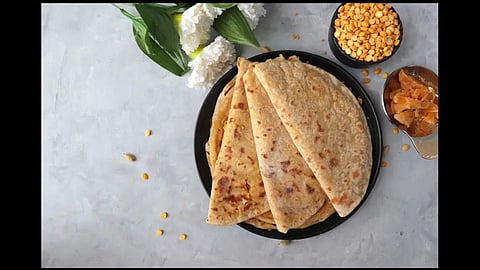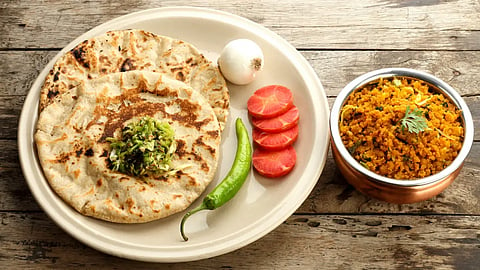With utmost concentration I carefully dissected what was on my plate — a host of unfamiliar items, each more rich looking than the other. While some names sounded familiar, the others were completely new. I carefully picked up a pea-sized amount of thecha and the rest is history. Apart from its rich architecture, fortifications and culture Maharashtra is also home to a diverse plate. With flavours and spice levels changing every few kilometres, the state’s cuisine has something for everyone. And if you’re planning to head to the state here is your guide to eat like a local in Maharashtra:
Eat Like A Local In Maharashtra
If you travel for food, here is your ultimate guide to the local favourites in Maharashtra
Alu Wadi

A deep fried and crunchy Maharashtrian snack, Alu Wadi is generally prepared during festivals and special occasions. The preparation involves colocasia leaves and chickpea flour. The leaves are first dried, then laden with chickpea flour and a spice mix and then deep fried. For a healthier version some also opt to steam them instead of frying. Lightly sweet and mostly savoury the snack is best served with tea or can be enjoyed alone as well. In the northern part of the country, the roots of the same plant are consumed as a vegetable — arbi.
Mutton Kala Rassa
With a massive fanbase in the Konkan belt, the mutton kala rassa is a huge favourite amongst the locals. Known for its juicy flavours, the spice mix that lends it the colour and flavour, the dish is slow cooked for a long period of time. One can taste the charred onions, earthy masalas and a raw smoky flavour in the final output. If you’re someone who cherishes the slow cooked dish, then this local dish will woo you wholeheartedly.
Puran Poli with Amti

One of the most popular Maharashtrian dishes is the puran poli. It is a sweet flatbread made with chana dal and jaggery filling traditionally. Collequially, the filling inside is called puran and the outer flatbread is called poli. It is generally served with copious amounts of ghee along with accompaniments such as amti. A heavily traditional combination with puran poli, amti is a spicy dish made using the water left after cooking the dal used for puran poli. The word amti translates to tangy with a combination of spice and sweetness.
Gavran Chicken
Loaded on spices and local flavours, this chicken curry comes from the smaller villages in the state. Served generally with rice or bhakri (more on this later), it is also known as Gavthi chicken and takes longer to cook. With the aroma of the curry reaching one before the actual dish, it is made with very few ingredients but copious amounts of spices, oil and a homemade chicken masala.
Vangi Bharit and Pitla

This traditional Maharashtrian preparation is aubergine cooked in a local style. Vangi stands for aubergine in marathi. With mild spices and a smoky flavour, this local dish is a staple. With hints of mustard, peanuts and the flavours of the smoked aubergine, it is best cherished when freshly prepared. While the vangi bharit is a dry dish, the pitla is a Maharashtrian curry. Prepared with gram flour, onions and green chillies, it is a thick curry that is served with bhakri and is a common find at most roadside dhabas.
Thecha
One of the spiciest things on the menu, thecha is a local favourite for all age groups. An accompaniment, the thecha is a spicy combo of green chillies, peanuts, coriander and garlic. Traditionally, it is made patiently in a pestle and mortar by manually grinding all items together. It is made in small batches and stored for about two to three days to keep its freshness intact.
Bhakri

The perfect pairing of all the dishes and even thecha is with the humble bhakri. Made with jowar, bajra or even whole wheat, the bhakri is coarser in texture. This round flatbread is also served with dollops of ghee and a perfect accompaniment for all Maharashtrian staple dishes.